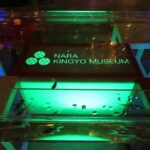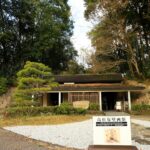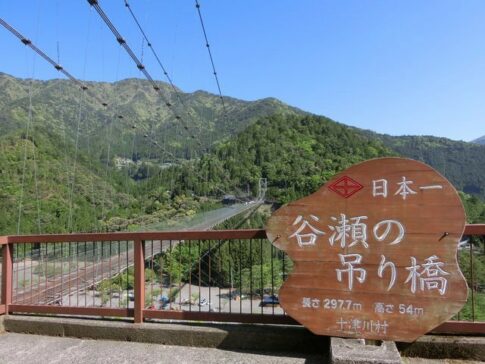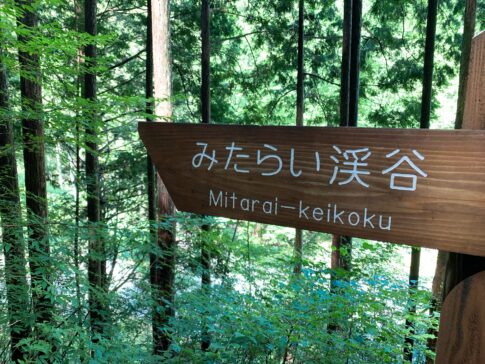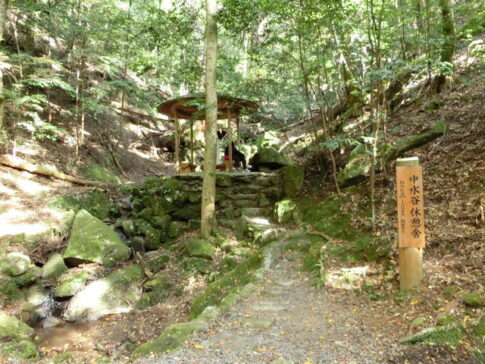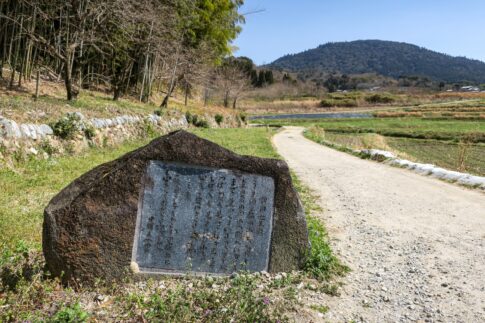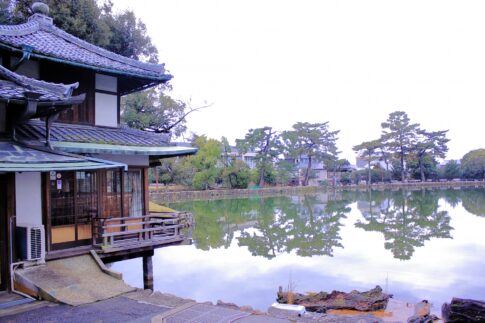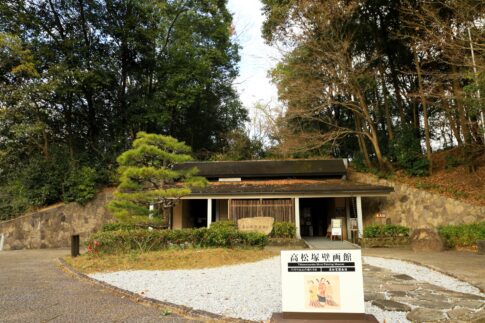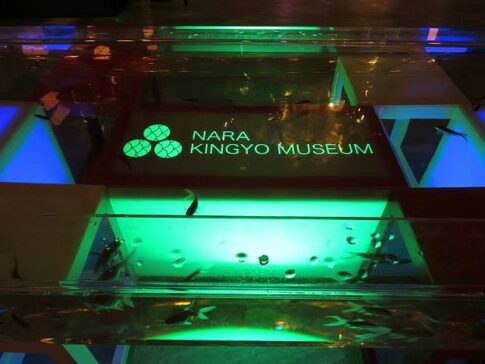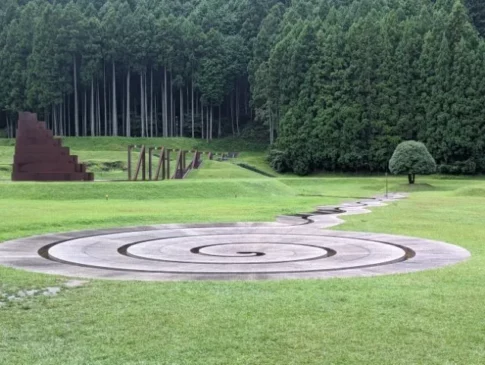Kameishi is a stone structure located in Kawahara, Asuka Village, Takaichi County, Nara Prefecture.
Along with Masuda Iwafune and Shufuneishi, it is known as a representative Asuka stone structure site.
What you need to know before visiting Kameishi
It is a mysterious and interesting spot to see!
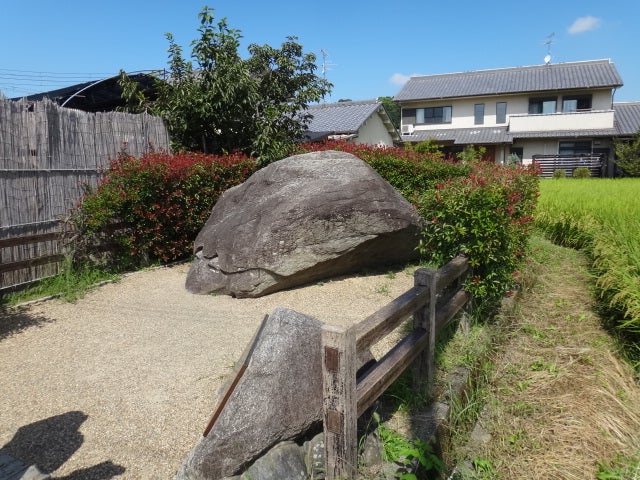
1. Shape of Kameishi
Kameishi is so named because of the turtle-like carving on the huge granite rock, 3.6 meters long, 2.1 meters wide, and 1.8 meters high.
With its humorous face, it has become a symbol of Asuka Village tourism.
Although it is called a turtle stone, there is a theory that it is more like a frog, since its face is triangular and its eyes protrude upward, while a turtle would have an oval face and eyes on the side.
However, the fact that a similar relief work was done on the core foundation of the pagoda and reliquary at the “Nonaka-ji old temple site” has led to a growing theory that the turtle stone also represents a tortoise.
The face is carefully finished, but the back and other parts have not been altered, and the eastern half of the lower abdomen has a lattice-like groove similar to that on the Masuda Iwafune.
A report by the Nara National Research Institute for Cultural Properties points out that the upper part is still natural stone and the eastern half of the lower surface is latticework, while the western half has been worked into a flat surface, and although there is a theory that the present lower surface is the original upper surface and was actually upside down, it is not considered a strong theory.
2. Construction date and purpose
Both the date and purpose of construction are unknown, and although several theories have been put forward, no conclusion has been reached.
A stone marker marking the southwestern corner of Kawahara-dera’s territory the boundary of the Jori (village).
The theory that it is an unfinished statue of a monkey stone.
In 647, when Prince Kim Chunju of Silla came to Korea as a diplomatic envoy, the stone was sculpted and installed by stone masons from Silla for welcoming him, and dances and music were performed around it.
Objects of indigenous beliefs (statues of deities) before the arrival of Buddhism.
An attempt was made to create a statue of a griffin during the reign of Emperor Saimei, but it was abandoned mid-process due to the fall of the Soga clan in the Otomi Incident, and it was left untouched.
3. Legend of Kameishi
According to legend, when the entire Yamato Basin was a lake, a battle between a snake from Toma on the opposite shore and a catfish from the riverbank resulted in the former winning, and as a result of the water being sucked out, the lake dried up and all the turtles in the lake died.
The villagers, feeling sorry for this, built a “turtle stone” to make a memorial service.
The turtle stone first faced north, then east. And now it faces southwest.
It is said that when it faces west in the direction of Toma, the whole Yamato Province will be turned into a sea of mud.
In fact, a survey of the Kame no back landslide area shows that in ancient times, the Yamato River was blocked by a landslide and became lake-like from the Kame no back area to well upstream.
4. Other Stone Structures in Nara
There are many stone structures in the Asuka area, including many mysterious ones such as the Turtle Stone and Monkey Stone, which provide a sense of the romance of ancient history.
- Turtle-shaped stone sculpture
Measuring approximately 2.4 m in length and 2 m in width, the turtle-shaped stone structure is designed so that water flowing out of the koban-shaped stone structure passes through the nose of the turtle and is stored in a water tank on its back.
It is now thought to be a site related to the rituals of Emperor Saimei (the Emperor of the Imperial Palace).
Visitor Information
Admission hours: 8:30-17:00 (9:00-16:00 from December to February)
Closed: Open all year round
Admission Fee 300 yen
Access Bus stop “Manyo Bunka Kan West Exit
Parking lot: not available
Location Oaza-oka, Asuka-mura, Takaichi-gun, Nara Pref.
- Sakafuneishi
A huge granite rock with strange carvings on its flattened surface.
The name “Sakafuneishi” comes from a legend that the stone was used for sake brewing.
A masonry ditch and a wooden gutter have been found in the vicinity, suggesting that it was a water-related facility.
Location Guide
Location Oaza-oka, Asuka-mura, Takaichi-gun, Nara Prefecture
Access 3 min. walk from Oka Tenrikyo-mae bus stop.
Parking lot: not available
- Kameishi(Turtle Stone)
A huge natural granite stone carved to resemble a turtle.
The stone used to face east and now faces southwest, but legend has it that when it faces west, the whole Yamato area will be turned into a sea of mud.
Location Guide
Location Oaza Kawahara, Asuka Village, Takaichi County, Nara Prefecture
Access 1 min. walk from bus stop “Chuo Kominkan”.
Parking lot is not available.
- Two-faced stone
A man and woman’s faces are carved on either side of a 1-meter high stone, which is believed to represent the two phases of the human heart, good and evil.
The stone is located inside Tachibana Temple and requires an entrance fee.
Visitor Information
Hours: 9:00-16:30
Closed: Open throughout the year
Admission 350 yen
Access 2 min. walk from bus stop “Kawahara
Parking lot available
Location 532 Tachibana, Asuka-mura, Takaichi-gun, Nara
- Monkey Stone
Three of the four stones have faces on the back as well, all resembling monkeys, hence the name, but the date and purpose of their creation remain a mystery.
Location Guide
Location Oaza Kurihara, Asuka-mura, Takaichi-gun, Nara
Access: 7 min. walk from Kintetsu Asuka Station
Parking lot is not available.
Summary
Nara Prefecture has a wide variety of attractive spots for tourists because the city has a long history.
If you are interested in Japanese history and mysterious thing, you can enjoy these places!

